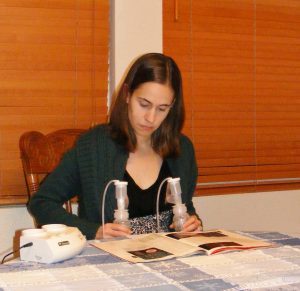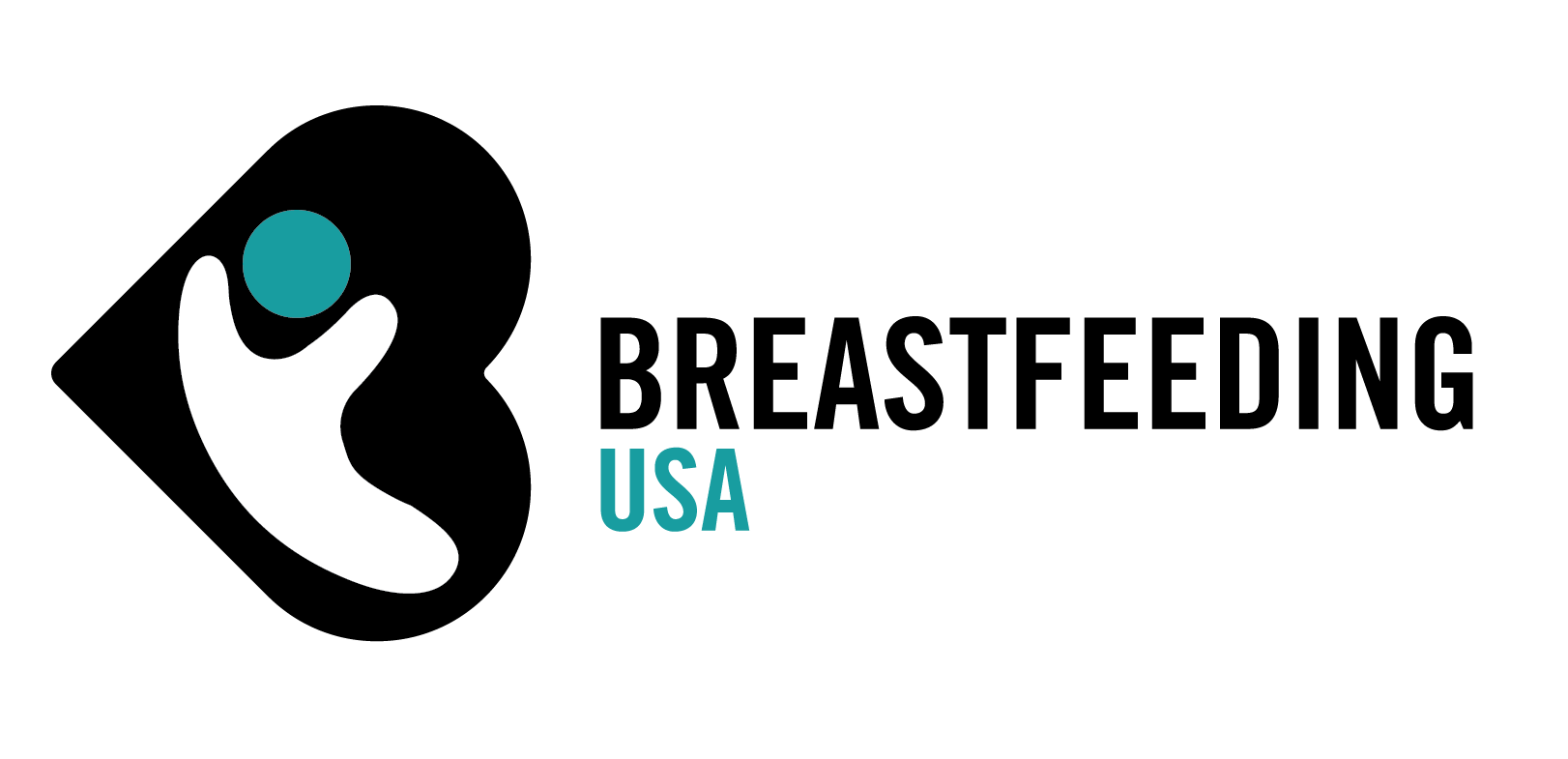By Ann Dempsey

Are you an employed or student mom who just so happens to be breastfeeding your baby, or a breastfeeding mom who is employed or attends school full time? Whether you identify more with your role as a breastfeeder or an employed/student mom, your pump is the lifeline that connects you to your baby when you are separated. Love or hate your pump, wouldn’t it be a dream to minimize the amount of time and effort that goes into the ritual of pumping?
Time Saving Tricks
- Enlist help: If your partner is looking for a way to lighten your load, a great way to support you is to take on the nightly duty of washing your pump parts and packing your pump bag for the next day.
- Go hands free: A hands-free pumping bustier allows you to get your regular work done while expressing milk for your baby. Don’t want to shell out the extra cash for a special bra? You can also cut flange holes into an old sports bra or rig up your flanges using this rubber band trick.
- Stockpile parts: Get a second (or third) set of pump parts so you don’t spend as much time washing parts at work. Your partner or other family members (see #1 above!) can wash and sterilize them all in the dishwasher or in a microwave steam bag when you get home. As an added benefit, keeping an extra set of pump parts at work can avert a potential crisis if you forget a crucial piece.
- Be lazy: Depending on your situation, you may be able to get by without washing your pump parts after each use. Pump and accessory wipes are a great time saver, but they can be expensive. Some moms cut them into smaller sections to make them stretch farther. Another time saver is to put your fully-assembled pump parts in the fridge (covered with a plastic bag) in between pumping sessions. This may not be an ideal solution for some moms, especially those feeding premature or otherwise medically-fragile babies. Use your own judgment – you may decide that refrigerating pump parts and skipping a wash or two may work well for your needs. At the end of the work day, all parts should be thoroughly washed and dried.
Maximizing Milk Production
- Get in the zone: A 2011 study showed that mothers who listened to a guided relaxation recording for 20 minutes a day produced significantly more milk than those who didn’t. You can download the meditation for free or figure out which relaxation techniques work best for you.
- All hands on deck: Some moms find that a little pre-pumping breast massage can aid in milk letdown. Follow along with the one minute Jiggle, Roll, Stroke YouTube video, and you’ll be well on your way. Then, use hands-on pumping to get even more milk from each session. (Studies have shown that this simple technique can improve milk output by 48%!) After your pumping session is done, turn off the pump, and hand express any remaining milk directly into your pump flanges. You may be surprised that there is still milk in there that your pump couldn’t get!
- Protect your production: Don’t skip pumping sessions. (If you aren’t sure how often to pump, you can calculate your “magic number.” Make a standing appointment on your calendar or set an alarm on your phone to remind you to pump regularly while you are separated from your baby – and stick to it. Since milk production is based on supply and demand, each time you skip a pumping session you’re telling your body that the demand is less. Sooner or later, your body will respond by producing less.
Troubleshooting Lowered Production
- It’s not you, it’s the pump: Most moms who see a decrease in their pumping output mistakenly assume that they are losing their milk. But before you jump to that conclusion, rule out pump failure first. Pumps don’t sound any different when they gradually (or even suddenly) become less effective, so the only outward clue you may notice is that you aren’t pumping as much as before. One test you can try is to crank up your pump to the strongest suction possible, and if it’s not uncomfortable, it may not be performing at 100% capacity.
- Swap membranes: The easiest thing you can do is to install new membranes on your pump assemblies. See your user manual or a troubleshooting guide on the website for your pump for instructions. Membranes are generally supposed to be replaced every 4-6 months anyway, and you may see your production bounce back pretty quickly after replacing them.
- Test the suction: If new membranes don’t do the trick, you can have your pump suction tested to make sure that the motor isn’t dying. Many hospital lactation stores and support groups have the ability to test your pump’s suction. If the motor is, indeed, the problem, call the pump manufacturer; they’ve been known to send a new pump immediately, especially if it is still within the warranty period.
- Check your flanges: Did you know that pump flanges (aka breast shields or horns) aren’t one-size-fits-all, and ill-fitting flanges can cause pain, damage, and sub-optimal milk output? Find out your ideal flange fit and re-evaluate from time to time. Your flange size can change through the course of lactation or even vary between your breasts. If you have a hard time finding the right size, you can try Pumpin Pals, which offer an alternative with more flexibility in sizing.
- NOTE: Not all pumps are created equal! This article can help you decide which pumps may be the best choice for your particular situation.
- It’s not you, it’s your caregiver: When moms struggle to keep up with the volume their babies are consuming during their absence, their first instinct is to think they’re not pumping enough. In many cases, moms are pumping enough, but the babies are being overfed by their caregiver. Most breastfed babies will take an average of 1-1.5 oz per hour of separation; if your baby is being fed significantly more than that, or your caregiver is pressuring you to provide more milk than you are able to pump, consider sharing this information about bottle-feeding techniques for breastfed babies and paced bottle-feeding.
- Okay, maybe it is you: If you’ve ruled out a faulty pump and overfeeding, you can take measures to maximize your pumping output. The most effective way to increase milk production is to increase demand. Adding an additional daily pumping session or two, or renting a hospital-grade pump for a few weeks, may help your production to bounce back; if not, it’s time to make an appointment with an IBCLC (International Board Certified Lactation Consultant) for a professional evaluation.
Storing, Freezing, and Organizing Milk
- Stay organized:
- Freeze your milk storage bags flat to save space and make it easy to organize your freezer stash.
- Repurpose a gift bag (or shoe box) to cycle through the oldest milk first: You can organize the milk vertically from left (oldest) to right (newest), taking from the left and stocking the right with newly-frozen milk. Another method is to cut a slit in the bottom side edge of the gift bag (and reinforce the opening with tape). Add newly-frozen milk to the top, and slide the oldest milk out of the opening at the bottom.
- Freeze only once a week, providing the previous day’s pumped milk to the caregiver. Fresh milk contains optimal nutrition and antibodies and will save you money in freezer bags. However, you can freeze your milk on Friday and cycle through your oldest freezer milk on Monday to keep your milk from exceeding recommended storage guidelines.
- Think twice before grabbing milk out of the freezer: To avoid unwittingly sabotaging your production, make a commitment to yourself and to your baby to pump to replace any milk your baby takes from a bottle. This cautionary tale should be required reading for every pump-owning mom.
Managing Travel
- Bring your baby! Consider creative ways to bring your baby with you on your trip. Invite a relative or friend to join you to care for the baby so you can nurse when you’re not in meetings or classes. If your employer is paying for your hotel, it may be worth the cost of the companion’s airfare to avoid extended separation from your baby. Even without a companion, you may be able to find a caregiver in your destination city.
- Plan ahead for air travel: Locate your airport’s best lactation rooms, and read up on the TSA’s regulations for flying with breast milk before you go.
Book Recommendations:
- Working and Breastfeeding Made Simple by Nancy Mohrbacher
- Working without Weaning by Kirsten Berggren
- Balancing Breast & Bottle by Amy Peterson and Mindy Harmer
- Exclusively Pumping your Milk by Stephanie Casemore
Online Resources:
- Breastfeeding USA: Hand Expression
- Breastfeeding USA: To Pump More Milk, Use Hands-On Pumping
- Breastfeeding USA: The ‘Magic Number’ and Long-Term Milk Production
- Breastfeeding USA: Choosing a Breast Pump
- Balancing Breast and Bottle
- Best for Babes: A Babe’s Guide to Pumping
- Breastfeeding Mom’s Guide to Returning from Maternity Leave
- Breastfeeding in Combat Boots
- Kellymom.com: Hands-free Pumping
- Pubmed: Combining hand techniques with electric pumping increases milk production in mothers of preterm infants
- Academy of Breastfeeding Medicine: An Audio Galactagogue (Relaxation Meditation)
- Jiggle, Roll, Stroke (YouTube tutorial)
- Ameda: Good Breast Flange Fit
- Pumpin’ Pals alternative pump flanges
- Nancy Mohrbacher: For the Caregiver of a Breastfed Baby
- Nurtured Child: Baby-Led Bottle Feeding
- Stanford Medicine: Maximize Milk Production with Hands On Pumping
- Kellymom.com: Milk Storage Guidelines
- Parenting in the Workplace Institute
- The Working, Traveling, Pumping, Nursing Mother
- TSA: Traveling with Children
Ann Dempsey
Ann has been a Breastfeeding Counselor since 2013. She is the Development Director at Cooperative for Education, helping Guatemalan children break the cycle of poverty through education. Ann resides in Indianapolis with her husband and two kids.
© Copyright Breastfeeding USA 2015. All rights are reserved.
